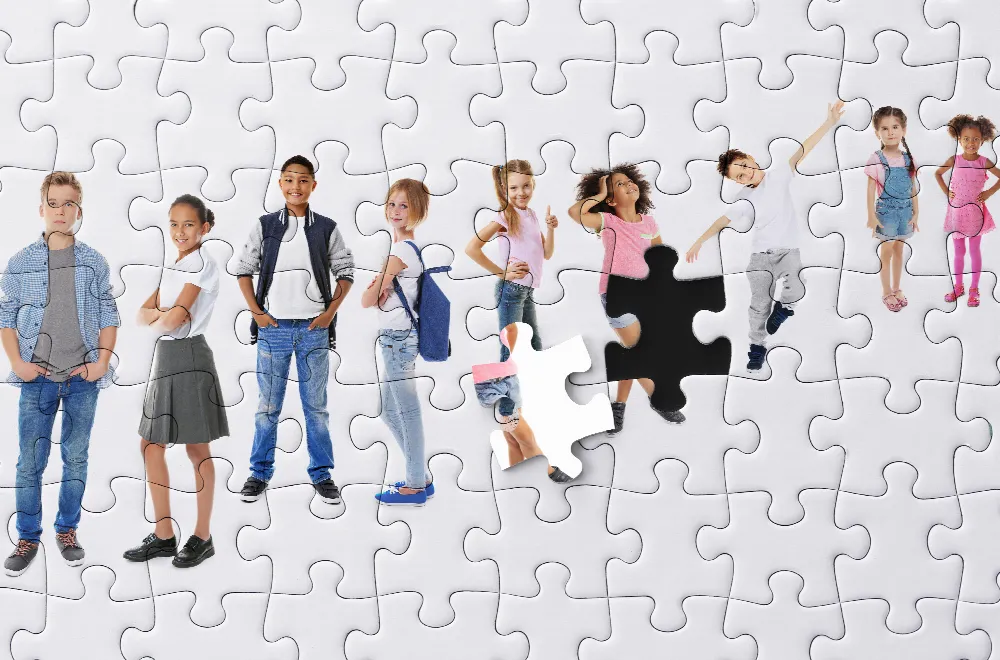Jigsaw Puzzle Piece Count by Age

There's more than age and piece count to consider when selecting the perfect jigsaw puzzle, but it's a good place to start.

Jigsaw puzzles have been a popular pastime for many years. They not only provide entertainment but also challenge our cognitive abilities. From young children to the elderly, people of all ages enjoy solving puzzles. However, the ability to solve jigsaw puzzles varies based on cognitive development and age. In this article, we will discuss the cognitive development and ability of various age groups as it relates to solving jigsaw puzzles, but first, lets get to why you're probably here.
Here's a general guideline covering ages and capabilities:- Age 2: 2-10 Pieces
- Age 3: 2-50 Pieces
- Age 4: 10-50 Pieces
- Age 5: 10-100 Pieces
- Age 6: 50-200 Pieces
- Age 7: 100-200 Pieces
- Age 8: 200-300 Pieces
- Age 9: 300-500 Pieces
- Age 10: 300-500 Pieces
- Age 11: 300-500 Pieces
- Age 12: 300+ Pieces
- Age 13 and up: 500+ Pieces
Preschoolers have just begun to develop their cognitive skills, including their ability to solve puzzles. At this age, they are still learning to match shapes and colors and have not yet developed the ability to understand complex relationships between puzzle pieces. However, they are great at simple puzzles with large pieces that fit together easily.
Children at this age typically enjoy puzzles with pictures of animals, cartoon characters, and other familiar objects. They are also attracted to bright colors, making puzzles with vivid hues more engaging for them. Puzzles with a limited number of pieces, such as those with 10-20 pieces, are ideal for preschoolers. These puzzles are perfect for developing their hand-eye coordination, fine motor skills, and visual-spatial skills.
Elementary School Age (6-11 years)As children grow older, they become better at solving puzzles. They have developed their ability to recognize patterns, which is essential for solving jigsaw puzzles. Children in this age group can handle more complex puzzles with more pieces than preschoolers. They can solve puzzles with 50 to 100 pieces and more.
At this age, children start to develop their problem-solving skills, which helps them to solve more challenging puzzles. They can also handle puzzles with irregular shapes, making them more capable of dealing with challenging puzzles.
In terms of puzzle preferences, children in this age group enjoy puzzles with more intricate designs, such as landscapes, cityscapes, and famous landmarks. Puzzles with their favorite characters or hobbies are also popular with children in this age group.
Adolescence (12-18 years)Adolescents have already developed their cognitive abilities to a significant extent. They can handle puzzles with hundreds of pieces and even thousands. They have improved their attention to detail, which is crucial when solving puzzles with intricate designs.
Adolescents are also better at manipulating puzzle pieces to fit together. They can rotate pieces and look at them from different angles to determine where they fit, a skill that is essential for solving challenging puzzles. They also have better problem-solving skills, which enable them to develop strategies to solve the most challenging puzzles.
Adolescents typically prefer puzzles with more complicated designs, such as those with abstract patterns or difficult landscapes. They also enjoy puzzles with a lot of details and elements to keep their minds active and engaged.
Adulthood (19-65 years)Adults are great at solving jigsaw puzzles. They have developed their cognitive abilities to a significant extent and can handle puzzles with thousands of pieces. They have honed their attention to detail, and their problem-solving skills are exceptional.
Adults enjoy puzzles that challenge them mentally and require a lot of time and effort to complete. They also enjoy puzzles with complex designs and intricate details. Puzzles that require a lot of patience and perseverance are also popular with adults.
Retirees (65 years and older)The cognitive abilities of retirees vary depending on their overall health and lifestyle. However, solving jigsaw puzzles is an excellent way for retirees to exercise their minds and keep their cognitive abilities sharp.
Retirees can handle puzzles with hundreds of pieces, but they may need more time to complete them. They may also require larger puzzle pieces to compensate for their reduced vision and motor skills. Puzzles with simple designs, such as landscapes and animals, are popular with retirees.